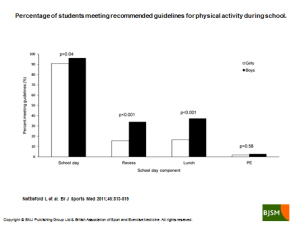Not surprisingly, the US senator who suggested that the one compulsory PE class per week in middle school should be made optional made news last week.
However, many folks fail to distinguish ‘phys ed’ from ‘physical activity’. The former is a structured class that may , or may not, involve much of the latter. Just as a maths class may not make students numerate, the ‘label’ on the class does not guarantee numeracy.We know of many well-intentioned PE teachers and PE advocates. We have tremendous emotional support for them. But let’s separate fact from emotion for a minute. What are the facts about physical activity in ‘PE’. Has anyone seen a PE class where a well-intentioned instructor does a lot of talking and the kids to a lot of bored standing?
Frighteningly, Nettlefold showed that recess provided more physical activity for primary (elementary) school children than did a longer period of Physical Education class. Only 5% of 8-11 year old children met the PHYSICAL ACTIVITY recommendations during PHYSICAL EDUCATION. This speaks to the disconnect between ‘phys ed’ and ‘physical activity’. Each is important but they are not synonymous.
The take home message is that when 5% of children meet physical activity guidelines during physical education, the latter is not the panacea for the epidemic of physical inactivity. Feel free to suggest how we can address the physical inactivity problem among children. And if you get time, sneak a look at this video going viral you YouTube (20,000 hits yesterday)
